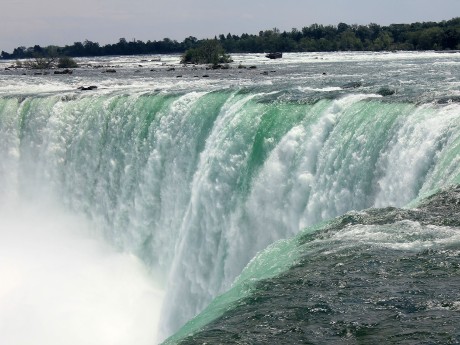Eastern Canada Highlights: Ontario & Quebec
World famous Niagara Falls, towering CN Tower, beautiful Thousand Islands in Toronto, the historic Fort Henry in Kingston, to Montreal's underground city and vibrant Quebec City, this trip highlights Eastern Canada at its finest. In the bustling city of Toronto, dive into the diverse cultural neighbourhoods such as the historic Distillery District and Kensington Market. Spend a day mesmerized by the thunderous Niagara Falls, and take boat tours like the Maid of the Mist.
Read more
World famous Niagara Falls, towering CN Tower, beautiful Thousand Islands in Toronto, the historic Fort Henry in Kingston, to Montreal's underground city and vibrant Quebec City, this trip highlights Eastern Canada at its finest. In the bustling city of Toronto, dive into the diverse cultural neighbourhoods such as the historic Distillery District and Kensington Market. Spend a day mesmerized by the thunderous Niagara Falls, and take boat tours like the Maid of the Mist. Explore the well-preserved Fort Henry with its captivating reenactments, and enjoy the views while on a walk at Kingston's waterfront. In Old Montreal, stroll through cobblestone streets and visit the awe-inspiring Notre-Dame Basilica. Explore the enchanting streets of Old Quebec, a UNESCO World Heritage site full of culture, history, and delicious food. Marvel at the iconic Château Frontenac and venture to the world-class Montmorency Falls, taller than Niagara Falls. From bustling cities to breathtaking landscapes, this trip promises an enriching journey through history, culture, and natural wonders. Waterviews strives to offer accommodation options within walking distance of water and/or in an area of touristic interest. Our prices include taxes (but excludes local tourist taxes). Customize your trip to your personal preferences with optional activities (hit the “Add Activities’’) or change hotels, etc. Contact us for customization at no extra cost at: Service@waterviewstravel.com
Destinations
- Toronto
- Niagara Falls (Ontario)
- Kingston (Ontario)
- Montreal
- Quebec City
Itinerary
Toronto
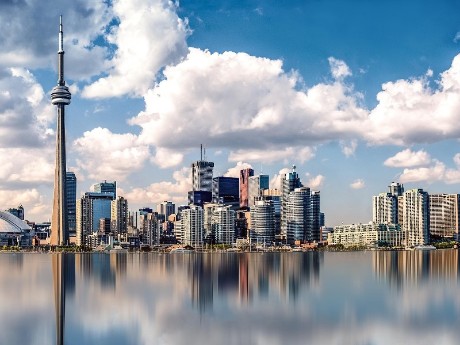
Visitors to Toronto are welcomed by its diverse population with famed Canadian friendliness and hospitality. Set along Lake Ontario’s Northern Shore, the city has something to offer for everyone and is home to countless restaurants, lively nightlife and a large cultural scene with theatre, art galleries and museums. Despite its big city status, Toronto offers a safe and peaceful environment as well as many green spaces and parks within its centre.
Read more
Visitors to Toronto are welcomed by its diverse population with famed Canadian friendliness and hospitality. Set along Lake Ontario’s Northern Shore, the city has something to offer for everyone and is home to countless restaurants, lively nightlife and a large cultural scene with theatre, art galleries and museums. Despite its big city status, Toronto offers a safe and peaceful environment as well as many green spaces and parks within its centre.
Additional Information
In 1998, the cities of Toronto, Scarborough, North York, Etobicoke, and York and the Borough of East York amalgamated to form the current City of Toronto. This is also known as Metropolitan Toronto; "the 416" after its area code (although now there are some new area codes, the overwhelming number of landline phone numbers in the Toronto area are still "416"); or more recently "the 6" (representing both the area code and the six cities involved in the amalgamation), and has a population of over 2.6 million people. More than half of these were born in some country other than Canada: a fact obvious to any visitor immediately, as the city has many vibrant bustling neighbourhoods with street signs in several languages.
Toronto and its surrounding suburbs are collectively known as the Greater Toronto Area (GTA). Outlying suburbs are also known as "the 905" after their area code, although this code is also used in the Hamilton and the Niagara Region, stretching from Cobourg and Colborne in the east to the border in Niagara Falls to the southwest. The entire area including Toronto is known as the "Golden Horseshoe" and has a population of over 8 million people. Distances between cities in the area can be great as it sprawls along, outward and even wraps around the western end of Lake Ontario; public transit is not always effective enough to make it a quick or seamless trip. Many suburban residents rely on private cars to get around.
A popular urban myth has it that the United Nations rated Toronto as "the most multicultural city in the world". While the UN and its agencies are not in the habit of rating cities, it remains a fact that Canada is a nation of immigrants, and Toronto demonstrates this abundantly. A UN agency lists Toronto as second only to Miami as the city with the most foreign-born residents, but Toronto's residents represent far more cultural and language groups, which is arguably a better measure of multi-culturalism. Most immigrants either pass through Toronto on their way to other parts of the country or stay in Toronto permanently. Many people born abroad consider themselves Canadian as much as native-born Canadians and will be offended if treated otherwise. This contributes to the overall cultural mosaic that is Toronto today. Within Toronto, most ethnic groups will work their way into the fabric of Canadian society but some still retain their distinct ways such as language, dress (if only for special occasions), customs, and food.
As a result of this cultural mosaic, Toronto is home to many ethnic festivals throughout the year. Toronto also has several radio stations that broadcast in various languages, and two multilingual television channels. The City of Toronto officially deals in 16 different languages while the Toronto Transit Commission (public transit) has a helpline that deals in 70 languages. Even large department stores such as The Bay in downtown Toronto proudly advertise service in 9 languages. The lingua franca of Toronto, however, remains English.
Climate
Toronto's climate is on the whole on the cool side, and variable conditions can be expected. Come prepared for winter: winters are cold (temperatures average -3.8°C (25°F) in January), mostly cloudy, at times snowy and uncomfortably windy. However, the type of extreme cold experienced further north in Canada usually lasts for no more than a couple of days at a time. The city experiences warm and humid summers with an average high of 27°C (80°F) and a low of 18°C (65°F) in July/August with many muggy evenings but rarely extreme heat. On average, the temperature exceeds 30°C (86°F) only 12 days per year, but hotter air masses often arrive with moderately high humidity levels. Late spring/early summer and early fall are generally considered to be the best times to visit for weather and less crowds, mid-summer is the peak tourist season, but visitors will find that Toronto's vibrancy extends through the winter with outdoor skating rinks and bundled up club-goers, etc. Toronto's public buildings are nearly all air-conditioned and fully heated.
Sometimes during the winter, severe storms can slow down transportation and activities in the city for a day or two. In the summer, thunderstorms occur from time to time, most lasting less than an hour.
Areas closer to the downtown core are generally 1 to 1.5°C warmer in winter due to the urban heat island effect. For the rest of the year, areas close to Lake Ontario are warmer by about 1°C due to the moderating effects of the lake. This is especially prominent in March and November when the city receives rain while areas just north of the city receive snow.
Visitor information
© Sourced from Wikivoyage
Niagara Falls (Ontario)
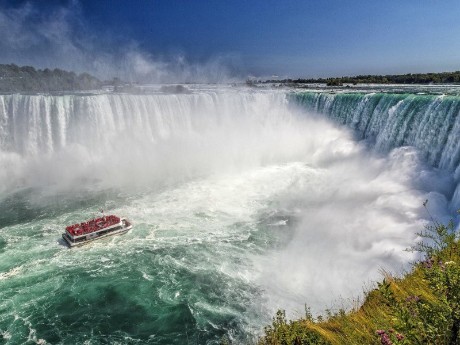
An unstoppable flow of rushing water surges over the arcing fault in the riverbed with thunderous force. Great plumes of icy mist rise for hundreds of meters as the waters collide, like an ethereal veil concealing the vast rift behind the torrent. Thousands of onlookers delight in the spectacle every day, drawn by the force of the current and the hypnotic mist.
Read more
An unstoppable flow of rushing water surges over the arcing fault in the riverbed with thunderous force. Great plumes of icy mist rise for hundreds of meters as the waters collide, like an ethereal veil concealing the vast rift behind the torrent. Thousands of onlookers delight in the spectacle every day, drawn by the force of the current and the hypnotic mist.
Additional Information
Niagara Falls was incorporated on June 12, 1903. Its population was 88,000 in 2016.
Mainly a tourist destination, the main attraction has always been Niagara Falls, which brings hundreds of thousands of tourists to the city. Tourism plays a major part in the economy of the region. Increasingly, visitors seeking more natural settings are finding the Niagara River to a great place to hike and visit downstream from the Falls where the majority of visitors go.
Visitor Welcome Centres open daily at 9AM, June through August. They offer advice and maps of the area, and sell People Mover bus tickets and the Great Gorge Adventure Pass. They are located at: Table Rock Centre (inside the mall near the brink of the Horseshoe Falls) Maid of the Mist (outside the Maid of the Mist ticket booths) Clifton Hill (at the intersection of Clifton Hill and Falls Avenue) Clifton Hill District (top of Clifton Hill Victoria Avenue area) Murray Street (near Queen Victoria Place, below the Fallsview Tourist Area and Fallsview Casino Resort)
Climate
Spring: Temperatures range from 5° to 19°C (41°-66°F). Nightly temperatures range from -3° to 8° C (26° to 46°F). As temperature changes are sudden outdoor camping before mid-May is not advisable.
Summer: In June, July & August the weather is generally bright and sunny with sporadic rainfall. Storms are caused by Lake Erie and Lake Ontario and are seldom severe.
Fall: In the fall, it is unlikely to snow prior to the end of October. First killing frost and/or snowfall be expected by late October or early November. Mixed weather patterns prevail. Rain and cloudy skies are common.
Winter: The days are generally cold and clear. Snow is moderate. Snow storms are infrequent. Lake effect snowfalls are mainly localized to areas near Buffalo and southward. Lake Erie, during extended cold weather will freeze over completely. Some of the activities associated with the falls (e.g. Maid of the Mist and Marineland) do not run during winter due to the frozen conditions, but most attractions now remain open year-round, dealing with mist-related ice near Niagara Falls.
© Sourced from Wikivoyage
Kingston (Ontario)
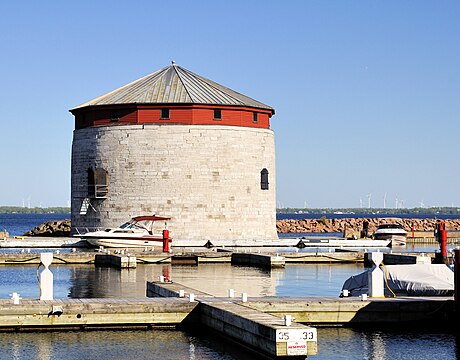
Once holding the title of Canada’s capital, Kingston is a small city with character. The cityscape is full of picturesque neighbourhoods lined with old churches and imposing Victorian mansions, and the location on the stunning Lake Ontario only adds to its charm.
Read more
Once holding the title of Canada’s capital, Kingston is a small city with character. The cityscape is full of picturesque neighbourhoods lined with old churches and imposing Victorian mansions, and the location on the stunning Lake Ontario only adds to its charm.
Additional Information
Kingston is one of the most historic cities in Canada with many churches, old buildings, picturesque neighbourhoods, and 19th-century fortifications. The city provides venues for nightlife such as clubbing and pubbing, and provides weekend escapes for people living in the neighbouring cities of Ottawa, Montreal and Toronto. There are ample historic sites and museums to visit, and many lively summer events.
Kingston is the home of two universities (Queen's University and Royal Military College) and one community college (St. Lawrence College). Along with tourism, these educational institutes and the students they attract provide much to the city's local economy. Kingston is also the home to a number of prisons.
Kingston is nicknamed the "Limestone City" because of the many heritage buildings constructed using local limestone.
History
The group that first occupied the area before the arrival of the French was probably the Wyandot people (Hurons), who were later displaced by Iroquoian groups.
At the time the French arrived in the Kingston area, Five Nations Iroquois (Haudenosaunee) had settled along the north shore of Lake Ontario. Although the area around the south end of the Cataraqui River was often visited by Iroquois and other groups, Iroquois settlement at this location only began after the French established their outpost. By 1700, the north shore Iroquois had moved south, and the area once occupied by the Iroquois (which includes Kingston) became occupied by the Mississaugas who had moved south from the Lake Huron and Lake Simcoe regions.
Growing European exploration in the 17th century and the desire for the Europeans to establish a presence close to local Aboriginal occupants to control trade led to the founding of a French trading post and military fort at a site known as "Cataraqui" (generally pronounced "kah-tah-ROCK-way") in 1673. This outpost, called Fort Cataraqui, and later Fort Frontenac, became a focus for settlement. Cataraqui was renamed Kingston after the British took possession of the fort and Loyalists began settling the region in the 1780s.
In 1783, the British governor of the Province of Quebec established a settlement for displaced British colonists, or "Loyalists", who were fleeing north because of the American Revolutionary War. The British Crown entered into an agreement with the Mississaugas in October 1783 to purchase land east of the Bay of Quinte.
During the War of 1812, Kingston (with a population of 2250) was a major military centre. It was the base for the Lake Ontario division of the Great Lakes British naval fleet, whose aim was to control Lake Ontario. Fort Henry was built on Point Henry in 1813. The present limestone citadel, constructed between 1832 and 1836, was intended to defend the Rideau Canal at the Lake Ontario end, the harbour and the naval dockyard.
Kingston became an important port for commodities shipped along the lake from the west. Wheat, flour, meat, and potash were unloaded and stored at Kingston to await transfer to vessels that could navigate the risky St. Lawrence.
Queen's University, originally Queen's College, one of the first liberal arts universities, first held classes in March 1842; established by the Presbyterian Church, it later became a national institution. The Royal Military College of Canada (RMC) was founded in 1876.
Kingston Penitentiary, Canada's first large federal penitentiary, was established in 1835 and operated until 2013. Several more prisons were established later in the greater Kingston area.
Kingston was chosen as the first capital of the united Canadas and it served in that role from 1841 to 1844. The city was considered too small and lacking in amenities, however, and its location near the border made it vulnerable to American attack. Subsequently, Kingston's growth slowed considerably and its national importance declined.
© Sourced from Wikivoyage
Montreal
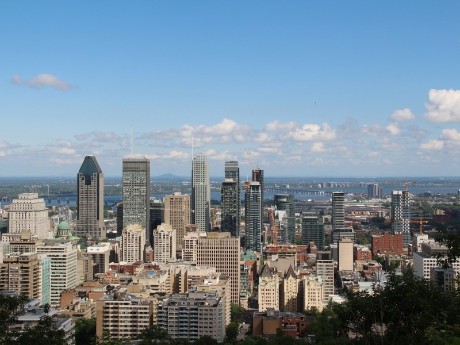
Montreal may not be the political centre of Quebec, but it certainly is the region’s cultural heart. Boasting itself as one of the most diverse cities of North America, French speaking Montreal dazzles with its architecture, frequent festivals and an excellent music scene. However, nothing is as persuading as the first-class gastronomy, which includes top-notch patisseries and cafés and outstanding restaurants and bars with an endless supply of local and international dishes.
Read more
Montreal may not be the political centre of Quebec, but it certainly is the region’s cultural heart. Boasting itself as one of the most diverse cities of North America, French speaking Montreal dazzles with its architecture, frequent festivals and an excellent music scene. However, nothing is as persuading as the first-class gastronomy, which includes top-notch patisseries and cafés and outstanding restaurants and bars with an endless supply of local and international dishes.
Additional Information
On an island in the St. Lawrence River at the historically highest navigable point, Montreal has been a strategic location since before the arrival of Europeans in Canada. A thriving Iroquoian town called Hochelaga was on the site of present-day Montreal when explorer Jacques Cartier first visited in 1535. In 1642, the tiny town of Ville-Marie was founded as a Catholic mission by Paul Chomedey, sieur de Maisonneuve. It soon became a centre of the fur trade. After its capture by the English in 1762, Montreal remained (until the 1970s) the most important city in Canada and was briefly capital of the province in the 1840s.
Prohibition on sales of alcohol in the United States during the 1920s and 1930s made Montreal a Mecca for cross-border fun seekers from nearby New England and New York. The city built up a seedy, yet playful, industry in alcohol, burlesque, and other vices. In the 1960s, an urban renewal drive centred on Expo 67. The World's Fair in Montreal brought a subway system (the métro) and attractive urban parks and is considered to be one of the most successful World Fairs. Over 50 million visitors gathered in Montreal during this memorable summer. The 1976 Olympics left a strikingly idiosyncratic stadium and many other urban improvements.
The opening of the Saint Lawrence Seaway in 1959, though much-lauded as an economic boom, spelled the beginning of the end for Montreal's economic dominance in Canada. Once the transition point between western railways and eastern sea carriers, Montreal watched helplessly as some of this business moved farther west, up the now navigable seaway, to ports in Ontario and on Lake Superior. The Quebec sovereignty movement, which began to pick up steam in the 1960s, further chilled the atmosphere for Canada-wide businesses, many of which moved their headquarters to Toronto.
Following an economic depression in the 1980s and 1990s, Montreal became more secure in its place in North America and the world. It remains a centre of culture, arts, computer technology, aerospace, the biotech industry, and media for all of Canada.
Orientation
It has been said that Montréal is the only city in the world where the sun "rises in the south".
Montrealers use an unconventional compass, using the river and the mountain as cardinal points. When you are downtown, the St Lawrence River is “south” and Mount Royal is “north”; making the West Island and the East End correct in both their names and orientations. This tends to confuse visitors because the “East” End is really north and the “South” Shore is east, and the St Lawrence River runs almost north-south at this location.
Most local maps use this convention as do the highways around the city. For example, Autoroute 15 north actually runs northwest and Autoroute 40 east runs northeast.
To underscore this fact, a Montreal map will show that the "south end" of Victoria Bridge is in fact further north than the "north end".
Gay Montreal
Montreal is an extremely inviting destination for gay and lesbian tourists. Canada's contributions to gay rights have become widely known, but Quebec was the first province in Canada to pass a non-discrimination law for sexual orientation and to provide same-sex civil unions (although Toronto was the first municipality in Canada to do so). Same-sex marriage is legal in Quebec (neither residency nor citizenship are required for a marriage licence, but there is a three-week waiting period after you receive the licence) as it is in the rest of Canada. Canadian and Quebec immigration law allow residents to sponsor their same-sex partners or spouses.
Montreal is a very safe, open, and inviting city. The métro station in the Gay Village, Beaudry, is marked with rainbow pillars. Divers/Cité Montreal's pride celebration (last week of July, first week of August) is the second-largest in Canada after Toronto's.
Climate
The climate of Montreal is a true humid continental climate with 4 distinct seasons. The city has warm—and occasionally hot & humid—summers, generally mild spring and autumn, and often very cold & snowy winters. Montreal gets over 2,000 hours of sunshine annually. Precipitation is moderate throughout the year, with around 2 metres of snow per season.
Visitor information
© Sourced from Wikivoyage
Quebec City
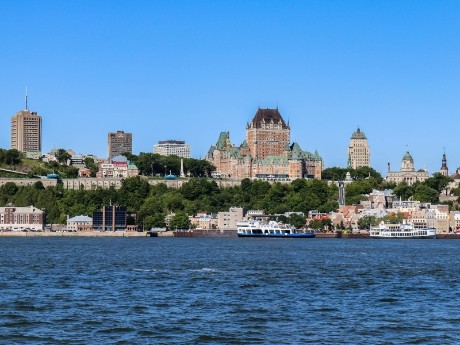
Settled on cliffs overlooking the St. Lawrence Seaway is Quebec City, a UNESCO World Heritage Site and the capital of Canada’s Quebec Province. Its colonial centre features winding cobblestone streets lined with bistros and boutiques, magnificent architecture dating from the 1600s, and is topped by the spectacular Château Frontenac. Quebec City mixes its history with modernity and hosts a wide range of cultural events including an incredible winter festival.
Read more
Settled on cliffs overlooking the St. Lawrence Seaway is Quebec City, a UNESCO World Heritage Site and the capital of Canada’s Quebec Province. Its colonial centre features winding cobblestone streets lined with bistros and boutiques, magnificent architecture dating from the 1600s, and is topped by the spectacular Château Frontenac. Quebec City mixes its history with modernity and hosts a wide range of cultural events including an incredible winter festival.
Additional Information
Quebec City is referred to as the National Capital in the province. Much of the business here is of the administrative and bureaucratic nature, which would normally make a city quite dull. Fortunately, the city has a remarkable history, as the fortress capital of New France since the 16th century. Although the town's day-to-day life leaves things a little yawny at times, the vibrant historical centre makes for an incredible visit.
Quebec was first settled by Europeans in 1608 in an "Habitation" led by Samuel de Champlain, and celebrated its 400th anniversary in 2008. The generally accepted dates of Champlain's arrival in the city, July 3rd and 4th, were marked with major celebrations. The area was also inhabited by Native peoples for many centuries before the arrival of the Europeans, and their ongoing presence has been notable since then.
When it was founded by the French to make a claim in the New World, the name Quebec referred to just the city. It is an Aboriginal word for "where the river narrows" as the St. Lawrence River dramatically closes in just east of the city. It rests on 65-m-high (200-foot) cliffs with stunning views of the surrounding Laurentian Mountains and the St. Lawrence River. Under French rule from 1608 to 1759, the major industries were the fur and lumber trades. The French lost the city and the whole colony of New France to the British in the Battle of the Plains of Abraham in 1759. Much of the French nobility returned to France, and the British assumed rule over the remaining French population. The rulers of the colony allowed the French to retain their language and religion, leaving much of the culture intact. In the 1840s, there was an influx of Irish immigrants during the Potato Famine. Due to cholera and typhus outbreaks, ships were quarantined at Grosse Isle to the east of the city past l'Île d'Orléans. The bodies of those who perished on the journey and while in quarantine are buried there. The city remained under British rule until 1867 when Canada West (Quebec) and Canada East (Ontario) joined New Brunswick and Nova Scotia to form the Dominion of Canada.
French is the official language of the province of Quebec though in the tourist areas of Quebec City, English is widely spoken as a second language by almost all of the staff. It is also not unusual to find Spanish, German and Japanese spoken in many establishments in Vieux-Quebec. Outside of the tourist areas, some knowledge of French is advisable and perhaps necessary, depending on how rural the area is. While older locals struggle when attempting to sustain a discussion in English, most people under 35 should be able to speak conversational English. Less than a third of the overall population is bilingual French/English.
In French, both the city and the province are referred to as Québec. Context determines the difference. By convention, the province is referred to with masculine articles (le Québec, du Québec, or au Québec), and the city takes no article at all (de Québec, à Québec). Provincial road signs and other official signage refer to Quebec City as simply Québec.
Quebec City was named the 5th best city destination in North America and 10th in the world in 2010 by Condé Nast Traveler, and best Canadian city for culture, 4th best Canadian destination, and 7th most romantic city in the world in 2010 by TripAdvisor.
Climate
Quebec has a humid continental climate, meaning there's considerable temperature variation over the year. Winters are cold with temperatures below -20°C certainly not unheard of (for a comparison to European destinations, the winter temperature range is comparable to Rovaniemi at the Arctic Circle while Quebec is at the same latitude as Central France!), with strong winds amplifying the cold temperature, and often also much snow.
Summer daytime temperatures are often just above +20°C, though it can get considerably hotter. Spring and fall tend to be rather short transition periods, and periods of warm weather far into the fall are common.
Orientation
Orienting yourself in Quebec is fairly easy. Many sights of interest are in the Old Town (Vieux-Québec), which constitutes the walled city on top of the hill. Many surrounding neighbourhoods, either in Haute-Ville ("Upper Town") or in Basse-Ville ("Lower Town"), are of great interest: Saint-Roch, Saint-Jean-Baptiste, Montcalm, Vieux-Port and Limoilou. Haute-Ville and Basse-Ville are connected by many staircases, all of which are unique, such as the aptly-named Escalier Casse-Cou ("Breakneck Stairs") and the more easily climbable "Funiculaire".
The city spreads westward from the St. Lawrence River, for the most part extending from the old city. The true downtown core of Quebec City is just west of the old city. Across the river from Quebec City is the town of Lévis. Frequent ferry service connects the two sides of the river.
Visitor information
© Sourced from Wikivoyage




